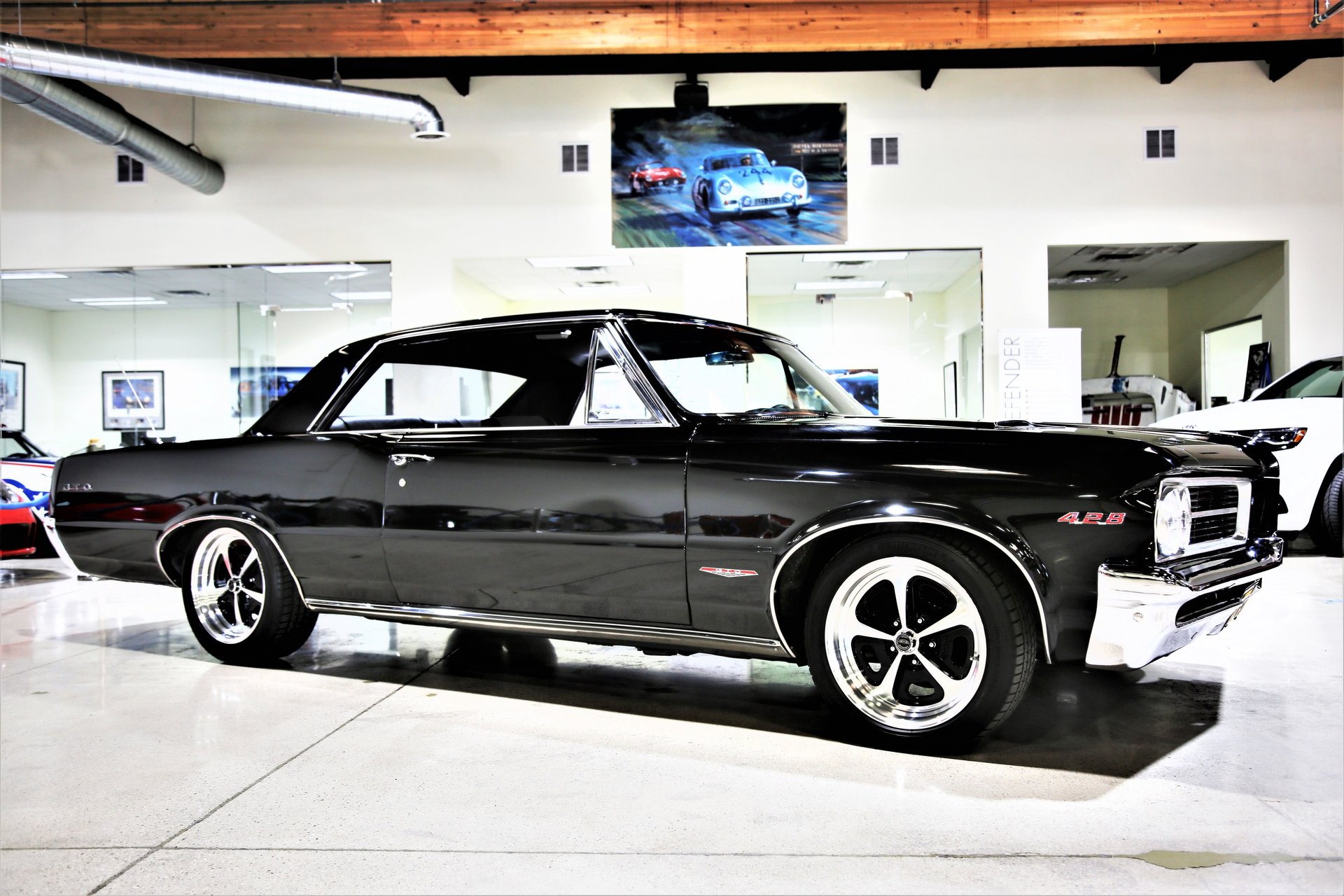The 1964 Pontiac GTO marks a pivotal moment in automotive history. This iconic vehicle revolutionized the American car market, introducing a new breed of high-performance automobiles that captured the imagination of speed enthusiasts across the nation.
The 1964 Pontiac GTO is widely considered the first true muscle car, setting the standard for a generation of powerful, affordable performance vehicles. Its combination of a large V8 engine in a mid-size body created a formula that other manufacturers would soon emulate, sparking a competitive era in Detroit.
The GTO’s impact extended beyond its impressive performance specs. It tapped into the youth culture of the 1960s, becoming a symbol of rebellion and freedom. This cultural significance, combined with its groundbreaking design, cemented the 1964 Pontiac GTO’s place in automotive lore.
The Birth of the Muscle Car
The 1964 Pontiac GTO sparked a new era in American automotive history. It combined a powerful V8 engine with a mid-size car body, creating a high-performance vehicle that appealed to young car enthusiasts.
Defining the Muscle Car
A muscle car typically features a large-displacement V8 engine in a lightweight, mid-size vehicle designed for street use and occasional drag racing. These cars prioritize straight-line acceleration and affordability over handling or luxury features.
Muscle cars often boast aggressive styling cues, such as hood scoops and bold graphics. They target young buyers seeking affordable performance and a rebellious image.
The formula proved successful, leading to intense competition among American automakers. Each brand sought to outdo rivals with increasingly powerful engines and eye-catching designs.
The Concept Behind the GTO
Pontiac’s development team, led by John DeLorean, conceived the GTO as a performance package for the Tempest model. They aimed to circumvent General Motors’ ban on racing by creating a street-legal car with race-inspired components.
The team installed a 389 cubic-inch V8 engine from the full-size Catalina into the lighter Tempest body. This combination produced an impressive power-to-weight ratio for its time.
Marketing played a crucial role in the GTO’s success. Pontiac promoted it as a youthful, exciting vehicle, tapping into the growing youth market of the 1960s.
The GTO’s name, borrowed from Ferrari’s Gran Turismo Omologato, added an air of exotic appeal to the American-made performance car.
Design and Engineering
The 1964 Pontiac GTO’s design and engineering set new standards for performance and style in American automobiles. Its powerful engine and sleek body combined to create a vehicle that would define the muscle car era.
Engine Specifications
The heart of the 1964 GTO was its potent 389 cubic inch V8 engine. This powerplant came in two versions:
- Standard: 325 horsepower
- Tri-Power: 348 horsepower
The Tri-Power option featured three two-barrel carburetors, providing improved performance and acceleration. Both engines were paired with either a 3-speed or 4-speed manual transmission, or a 2-speed automatic.
The GTO’s engine was derived from Pontiac’s full-size car line but modified for increased output. High-compression pistons, a high-lift camshaft, and free-flowing exhaust manifolds contributed to its impressive power figures.
Chassis and Body Design
The GTO was based on the compact Pontiac Tempest platform, which provided a lightweight foundation for the powerful engine. Key design elements included:
- Sleek, muscular body styling
- Dual hood scoops (non-functional, but visually striking)
- Wide-track stance for improved handling
The interior featured bucket seats and a floor-mounted shifter, emphasizing the car’s sporty nature. Pontiac offered the GTO in three body styles:
- Hardtop coupe
- Convertible
- Sports coupe (with B-pillars)
The GTO’s design blended performance cues with a refined aesthetic, setting it apart from more utilitarian muscle cars that would follow. Its well-proportioned lines and aggressive stance made it instantly recognizable on the street.
1964 Pontiac GTO in Popular Culture
The 1964 Pontiac GTO left an indelible mark on automotive culture and entertainment. Its iconic status influenced both automotive journalism and mainstream media for decades to come.
Automotive Media Reception
Car magazines of the 1960s praised the 1964 GTO’s performance and style. Motor Trend named it Car of the Year, highlighting its powerful V8 engine and sporty aesthetics. Car and Driver conducted a comparison test between the GTO and a Ferrari GTO, sparking controversy and publicity.
The automotive press coined the term “muscle car” to describe the GTO and its imitators. This classification became a staple in automotive journalism, shaping discussions about American performance cars for generations.
Influence on Music and Movies
The 1964 GTO featured prominently in popular music. Ronny and the Daytonas released “Little GTO” in 1964, which reached #4 on the Billboard Hot 100 chart. The song’s catchy lyrics celebrated the car’s speed and appeal.
In film, the GTO appeared in numerous productions. It played a central role in the 1966 drag racing movie “Fireball 500,” starring Frankie Avalon. The car’s screen presence solidified its status as a cultural icon.
Television shows also showcased the GTO. It made appearances in period dramas and car-centric programs, often symbolizing 1960s youth culture and rebellion.
Market Impact and Sales
The 1964 Pontiac GTO made a significant splash in the automotive market, reshaping consumer preferences and industry trends. Its introduction marked a pivotal moment for both Pontiac and the broader American car market.
Sales Figures and Market Reception
The 1964 GTO exceeded sales expectations, with Pontiac initially projecting 5,000 units for the year. Actual sales reached an impressive 32,450 vehicles. This success prompted a full model line for 1965, resulting in 75,342 GTOs sold.
Consumer enthusiasm was evident in the strong demand and positive reviews. Car and Driver magazine praised the GTO’s performance, helping to boost its popularity. The GTO appealed to younger buyers seeking affordable high-performance vehicles.
Pontiac’s clever marketing strategy, emphasizing the car’s power and style, contributed to its market success. The GTO quickly became a status symbol among automotive enthusiasts.
Effects on the Auto Industry
The GTO’s success sparked a new trend in the automotive industry. Other manufacturers rushed to develop their own muscle cars to compete with Pontiac’s hit model.
GM divisions like Chevrolet, Oldsmobile, and Buick introduced similar high-performance models. Ford and Chrysler also joined the muscle car race with models like the Mustang GT and Dodge Charger.
The GTO’s impact extended beyond sales figures. It influenced automotive design trends, with many competitors adopting similar styling cues and performance features.
This shift in the market led to a performance arms race among manufacturers, resulting in more powerful engines and innovative designs throughout the 1960s and early 1970s.
Technical Evolution
The 1964 Pontiac GTO underwent significant technical changes throughout its production years. These alterations improved performance and refined the muscle car concept.
Model Year Changes
The 1965 GTO saw the introduction of a restyled grille and new taillights. Engine options expanded, offering a 360-horsepower Tri-Power V8. In 1966, the GTO became a separate model rather than an option package.
1967 brought a major redesign with a new body style and concealed headlamps. The 1968 model featured a redesigned front end and the iconic Endura bumper.
1969 saw the introduction of the “Judge” package, which included a rear spoiler and unique styling elements. The 1970 GTO received a facelift with a new front grille and rear bumper.
Performance Upgrades
The GTO’s performance continually improved over the years. The original 389 cubic inch V8 engine was replaced by a 400 cubic inch V8 in 1967, offering increased power and torque.
Pontiac introduced the Ram Air induction system in 1965, boosting horsepower. The Ram Air IV option, available in 1969, provided even greater performance gains.
Transmission options expanded to include a close-ratio 4-speed manual and a 3-speed Turbo Hydra-Matic automatic. Suspension upgrades improved handling and ride quality.
The addition of front disc brakes in 1967 enhanced stopping power. Wider tires and upgraded wheel options improved traction and cornering abilities.
Collectibility and Legacy
The 1964 Pontiac GTO holds a special place in automotive history and continues to captivate car enthusiasts. Its groundbreaking design and performance have solidified its status as a highly sought-after classic.
Auction Records and Value Trends
Well-preserved 1964 GTOs command significant prices at auctions. In recent years, pristine examples have fetched over $100,000, with rare variants reaching even higher. The value of these cars has shown a steady upward trend since the 1990s.
Factors affecting GTO values include:
- Original condition
- Documentation
- Rarity of options
- Restoration quality
The most desirable 1964 GTOs feature the Tri-Power carburetion setup and four-speed manual transmission. Convertibles typically command a premium over hardtops.
Modern Interpretations and Tributes
The 1964 GTO’s influence extends beyond its original production run. Pontiac revived the GTO nameplate from 2004 to 2006, creating a modern muscle car inspired by its predecessor. This new GTO, while short-lived, paid homage to the original’s performance-oriented ethos.
Custom car builders frequently use the ’64 GTO as inspiration for restomod projects. These builds combine classic styling with modern powertrains and amenities. Several companies offer reproduction parts, allowing owners to restore or maintain their vintage GTOs.
The car’s legacy is also preserved through:
- Dedicated enthusiast clubs
- Specialized magazines
- Appearances in films and TV shows
Ownership and Restoration
Acquiring and restoring a 1964 Pontiac GTO requires dedication, expertise, and resources. The process involves careful searching and meticulous attention to detail during restoration.
Finding a 1964 GTO
Locating an authentic 1964 GTO can be challenging due to its age and desirability. Enthusiasts often search classic car dealerships, auctions, and online marketplaces. Prices vary widely based on condition, ranging from $20,000 for project cars to over $100,000 for pristine examples.
When evaluating a potential purchase, buyers should verify the VIN and documentation to ensure authenticity. Original GTOs have specific engine and body codes that distinguish them from other Pontiac models.
Rust is a common issue, particularly in the frame, floor pans, and quarter panels. A thorough inspection by a knowledgeable mechanic is crucial before making a purchase.
Restoration Tips
Restoring a 1964 GTO demands patience, skill, and access to specialized parts. Many owners opt for a frame-off restoration to address structural issues and ensure a high-quality result.
Key restoration steps include:
- Disassembly and documentation
- Frame repair and reinforcement
- Body work and paint
- Engine rebuilding or replacement
- Interior refurbishment
Sourcing original or reproduction parts can be challenging. Specialized suppliers and salvage yards are valuable resources for hard-to-find components.
Maintaining originality is often a priority for collectors. However, some owners choose to modify their GTOs with modern upgrades for improved performance and driveability.
Professional restoration shops can provide expertise and equipment for complex tasks, but costs can quickly escalate. Many enthusiasts tackle portions of the restoration themselves to manage expenses and gain hands-on experience.
References
- Hemmings (n.d.) – 1964 Pontiac GTO: The Car That Started the Muscle Car Era Link
- Pontiac Historical Services (n.d.) – GTO Production Data and Specifications Link
- Motor Trend (2004) – The Original Muscle Car: 1964 Pontiac GTO Retrospective Link
- Car and Driver (1964) – Pontiac GTO vs. Ferrari GTO: The Famous Comparison Link
- Smithsonian National Museum of American History (n.d.) – The GTO and American Car Culture Link
- Mecum Auctions (n.d.) – 1964 Pontiac GTO Valuation and Market Trends Link




